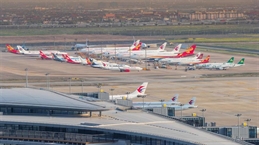
Airlines in the Asia Pacific region recorded a 13.9% year-on-year growth in international air cargo demand last year, driven by a surge in e-commerce and disruptions in maritime shipping.
Preliminary financial performance figures released by the Association of Asia Pacific Airlines (AAPA) showed that Asia Pacific carriers also saw a 10% increase in cargo revenue for 2024.
"For the year, a surge in e-commerce activity and disruptions to maritime shipping contributed to a solid 13.9% increase in international air cargo demand, as measured in freight tonne kilometres (FTK), following two consecutive years in decline," the Kuala Lumpur-based AAPA said.
Meanwhile, cargo revenue climbed by 10.3% to US$23.2 billion, although there was a 3.2% decline in air cargo yields to 32.7 US cents per FTK.
Combined net profit of US$7.3B in 2024
Overall, Asia Pacific carriers achieved US$7.3 billion in combined net profits in 2024, driven by a marked recovery in cargo volumes and strong growth in passenger traffic.
AAPA noted that despite this, the region's carriers faced a challenging operating environment due to ongoing supply chain constraints and rising operating costs.
Robust growth in business and leisure travel, both within the region and globally, also resulted in a 19.9% increase in systemwide passenger demand, in revenue passenger kilometer (RPK) terms.
Asia Pacific airlines recorded a 7.7% increase in operating revenue, reaching a combined total of US$213.9 billion in 2024, compared to US$198.6 billion in 2023.
Aggregated passenger revenue rose by 8.8% to US$170.4 billion. There was also a 9.2% decline in passenger yields to 8.0 US cents per RPK.
Meanwhile, combined operating expenses rose by 8.4% to US$199.8 billion for the year, due mainly to a 10.1% increase in non-fuel expenditure to US$138.9 billion.
Persistent supply chain challenges, including shortages of spare parts, aircraft delivery delays, and aircraft groundings due to engine issues, drove up maintenance and leasing costs. Inflationary pressures also contributed to higher staff expenditure and airport charges.
Fuel expenditure, the single largest cost item, rose by 4.8% to US$60.8 billion, in tandem with an increase in flights operated.
The increase was partly mitigated by a 13.4% decline in jet fuel prices to an average of US$98.1 per barrel in 2024. The share of fuel expenditure as a percentage of total operating costs averaged 30.5%, down from 31.5% in 2023.
Considerable headwinds ahead
"2024 was a year of remarkable resilience for Asia Pacific airlines, as carriers confronted multiple challenges while achieving strong growth in both passenger and cargo demand, along with record passenger load factors," AAPA Director General Subhas Menon said.
"However, airlines were not immune to cost pressures. The marked increase in operating expenses, particularly non-fuel costs, underscored the impact of supply chain constraints. Despite this, Asia Pacific airlines demonstrated their adaptability, delivering operating margins of 6.6% for the year, just 0.6 percentage points under the 7.2% in 2023."
Looking ahead, Menon said, the region's carriers continue to face "considerable headwinds," including elevated operating costs and ongoing supply chain disruptions.
"Geopolitical tensions may lead to renewed volatility in oil and currency markets while air cargo markets may soften further, as uncertainties over trade negotiations dampen demand for air shipments," Menon said.
"Nevertheless, air passenger demand is expected to remain relatively resilient, amidst continued growth in the region's economies. In response, airlines are actively refining their business strategies, maintaining cost discipline while pursuing new revenue streams. At the same time, carriers are investing in fleet modernisation, digital innovation, and enhanced service offerings," he added.



